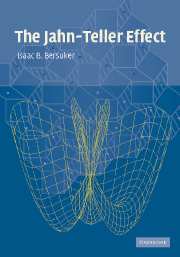Book contents
- Frontmatter
- Contents
- Preface
- Abbreviations
- 1 Introduction
- 2 Vibronic interactions
- 3 Formulation of Jahn–Teller problems. Adiabatic potentials
- 4 Pseudo Jahn–Teller, product Jahn–Teller, and Renner–Teller effects
- 5 Solutions of vibronic equations. Energy spectra and JT dynamics
- 6 The JTE in spectroscopy: general theory
- 7 Geometry, spectra, and reactivity of molecular systems
- 8 Solid-state problems: local properties and cooperative phenomena
- Appendix
- Subject index
- Formula index
7 - Geometry, spectra, and reactivity of molecular systems
Published online by Cambridge University Press: 07 December 2009
- Frontmatter
- Contents
- Preface
- Abbreviations
- 1 Introduction
- 2 Vibronic interactions
- 3 Formulation of Jahn–Teller problems. Adiabatic potentials
- 4 Pseudo Jahn–Teller, product Jahn–Teller, and Renner–Teller effects
- 5 Solutions of vibronic equations. Energy spectra and JT dynamics
- 6 The JTE in spectroscopy: general theory
- 7 Geometry, spectra, and reactivity of molecular systems
- 8 Solid-state problems: local properties and cooperative phenomena
- Appendix
- Subject index
- Formula index
Summary
General: JT vibronic coupling effects in geometry and reactivity
This chapter is devoted to applications of the JTE, PJTE, and RTE theory to solve the problems of origin of geometry and spectra, as well as other properties of molecular systems. With regard to geometry, as mentioned in the introduction, increased computer power allows sufficiently accurate calculations of APES of small to moderate-sized molecular systems to determine their absolute minima, which are assumed to define the molecular geometry. In many cases and for many electronic states, ground and excited, the APES are rather complicated: there may be several equivalent minima which do not correspond to the high-symmetry configuration that one may expect from a general, classical point of view. Instead, complicated dynamics due to the multi-minimum APES, anharmonicity, conical intersections, and lines of conical intersections may occur. Obviously, molecular properties other than geometry, including spectra and reactivity, are strongly dependent on the APES too.
On the other hand, as follows from the previous chapters, the JT vibronic effects are the only sources of instability of high-symmetry configurations. Therefore the vibronic effects may serve as a fundamental basis for understanding (rationalizing) the results of quantum-chemical computations (as well as results obtained by other methods). In addition, for large systems ab initio calculations with geometry optimization are impossible or impractical, leaving the perturbational vibronic approach as the only source of information on bulk and local instabilities.
- Type
- Chapter
- Information
- The Jahn-Teller Effect , pp. 353 - 478Publisher: Cambridge University PressPrint publication year: 2006

